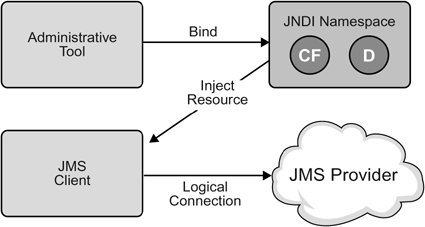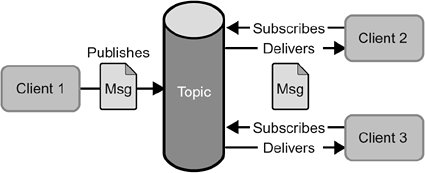Basic JMS API Concepts
| This section introduces the most basic JMS API concepts, the ones you must know to get started writing simple JMS client applications:
The next section introduces the JMS API programming model. Later sections cover more advanced concepts, including the ones you need to write Java EE applications that use message-driven beans. JMS API ArchitectureA JMS application is composed of the following parts.
Figure 312 illustrates the way these parts interact. Administrative tools allow you to bind destinations and connection factories into a JNDI namespace. A JMS client can then use resource injection to access the administered objects in the namespace and then establish a logical connection to the same objects through the JMS provider. Figure 312. JMS API Architecture Messaging DomainsBefore the JMS API existed, most messaging products supported either the point-to-point or the publish/subscribe approach to messaging. The JMS specification provides a separate domain for each approach and defines compliance for each domain. A stand-alone JMS provider can implement one or both domains. A Java EE provider must implement both domains. In fact, most implementations of the JMS API support both the point-to-point and the publish/subscribe domains, and some JMS clients combine the use of both domains in a single application. In this way, the JMS API has extended the power and flexibility of messaging products. The JMS 1.1 specification goes one step further: It provides common interfaces that enable you to use the JMS API in a way that is not specific to either domain. The following subsections describe the two messaging domains and then describe the use of the common interfaces. Point-to-Point Messaging DomainA point-to-point (PTP) product or application is built on the concept of message queues, senders, and receivers. Each message is addressed to a specific queue, and receiving clients extract messages from the queues established to hold their messages. Queues retain all messages sent to them until the messages are consumed or until the messages expire. PTP messaging has the following characteristics and is illustrated in Figure 313. Figure 313. Point-to-Point Messaging
Use PTP messaging when every message you send must be processed successfully by one consumer. Publish/Subscribe Messaging DomainIn a publish/subscribe (pub/sub) product or application, clients address messages to a topic, which functions somewhat like a bulletin board. Publishers and subscribers are generally anonymous and can dynamically publish or subscribe to the content hierarchy. The system takes care of distributing the messages arriving from a topic's multiple publishers to its multiple subscribers. Topics retain messages only as long as it takes to distribute them to current subscribers. Pub/sub messaging has the following characteristics.
The JMS API relaxes this timing dependency to some extent by allowing subscribers to create durable subscriptions, which receive messages sent while the subscribers are not active. Durable subscriptions provide the flexibility and reliability of queues but still allow clients to send messages to many recipients. For more information about durable subscriptions, see Creating Durable Subscriptions (page 1106). Use pub/sub messaging when each message can be processed by zero, one, or many consumers. Figure 314 illustrates pub/sub messaging. Figure 314. Publish/Subscribe Messaging Programming with the Common InterfacesVersion 1.1 of the JMS API allows you to use the same code to send and receive messages under either the PTP or the pub/sub domain. The destinations that you use remain domain-specific, and the behavior of the application will depend in part on whether you are using a queue or a topic. However, the code itself can be common to both domains, making your applications flexible and reusable. This tutorial describes and illustrates these common interfaces. Message ConsumptionMessaging products are inherently asynchronous: There is no fundamental timing dependency between the production and the consumption of a message. However, the JMS specification uses this term in a more precise sense. Messages can be consumed in either of two ways:
|


